Tv "Panther". A little more about the "Panzerva cat"
About armor
As is known, the German medium tanks during the war years received a differentiated reservation. It quickly became clear on the battlefields that armor in 30 mm was completely inadequate, but T-III and T-IV were relatively light machines: it was not possible to significantly increase their armor in all projections. Simply put, either the improvement would be too insignificant, or the weight of the car would exceed the capabilities of the engine, chassis and transmission, causing the tank to drastically lose in mobility and reliability. So the Germans found a relatively good way out - they only significantly increased the frontal projection of their tanks, with the result that the same T-IV had a thickness of individual nose parts of the hull up to 80 mm, and a tower forehead - up to 50 mm, while the sides of the hull and the towers covered no more than 30-mm armor.
And the newest tank "Panther", in fact, received protection according to the same concept: the forehead of the hull was protected by completely unkillable 85-mm armor, and also at rational angle of inclination (55 degrees), the thickness of the tower in the frontal projection reached 100- 110 mm, but the boards and feed were protected only by 40-45-mm armor plates.
There is no doubt that for T-III and T-IV, such differentiation of armor was fully justified, and, in fact, the only way to “tighten” their protection to modern requirements, even if only partially. But how justified is the use of the same principle on the "Panther", a tank that was created already during the Great Patriotic War? In the comments to the discussion of the articles in the series “Why T-34 lost to PzKpfw III, but won against Tigers and Panthers”, rather contradictory opinions were expressed on this subject: someone thought it was a mistake, someone - on the contrary, with a glimpse of German genius constructors. Try to understand this in more detail.
A small reservation. It is well known that, approximately since the summer of 1944, the quality of German tank armor for objective reasons has deteriorated sharply - to put it simply, the Germans lost control over the deposits of raw materials necessary for its production. Of course, this immediately affected the security of the German armored vehicles, and therefore it is customary to distinguish the armor protection of the "early" and "late" "Panthers" and other tanks. So, in this article we will focus exclusively on the perfectly protected "racially correct" "Panthers" of the early editions, since all the statistics and research given below were conducted in 1943.
So, the first question - did the Germans themselves believe that the Panther’s armor protection was optimal and fully responded to current challenges? The answer will be the most that is negative, because already at the end of 1942, many Wehrmacht military men expressed doubts about the quality of its armor protection. And in December 1942, the founders of MAN, the designers of the Panther company, began designing a more seriously protected modification of the Panthers - it was supposed to reinforce the frontal sheet from 85 to 100 mm, and the sides - from 40-45 mm to 60 mm. Strictly speaking, so began story “Panthers II”, because initially under this name it was supposed to produce practically the same “Panther”, but with enhanced booking, and only later decided to strengthen the tank’s weapons as well. And before that, it was assumed that the “Panther II” with the same cannon, but with improved armor, would go into series as soon as it was ready, replacing the “Panther” ausf.D.
Question two: to what extent did the armor protection of the German "cat" correspond to the level of the PTO of the Red Army in 1943? Let's not forget that the power of VET is made up of many components, the main of which are the quality of the equipment and the combat ability of the soldiers and officers serving it. So let's start with combat skills. How can it be expressed?
The fact that the Panthers had almost the ultimate defense of frontal projection, but relatively weak sides, was well known in the Red Army. Therefore, the main indicator of the professionalism of our troops is precisely the ability of anti-tankists to choose a position, etc., in order to hit the Panthers in relatively vulnerable boards and aft.
About striking "Panther"
The most interesting data on this topic was presented by the respected M. Kolomiets in the book “Heavy tank“ Panther ””. In 1943, the German troops launched a very strong counterattack near Oboya, as a result of which our troops of the Voronezh Front had to fight fiercely defensive battles. And, when the guns died down, a group of highly qualified officers of the Armed Forces Test Vehicle arrived at the break-through area along the Belgorod-Oboyan highway (30 at 35 km). Their goal was to study and analyze damage to the Panther tanks, which were shot down during defensive battles.
In total, a padded tank was examined by 31. Of these, 4 tanks failed for technical reasons, another was stuck in a trench, three were blown up by mines, and one was destroyed by a direct hit by a bomb. Accordingly, tank and anti-tank artillery was destroyed by 22 "Panthers".
In total, the 22 of Soviet shells hit these 58 Panthers. Of these, 10 landed in the front armor of the hull, and everyone ricocheted - no such tank failed from such hits. 16 shells hit the turret, a number of them gave punctures through, but the commission considered only the Panthers 4 to be incapacitated from damage by the towers. But in the board came the maximum hits - as many as 24, it was they who caused the failure of 13 German tanks. Our anti-tank crews managed to slam 7 shells into the stern of the Panther, which knocked out 5 tanks, and one last hit hit the cannon on one of them.
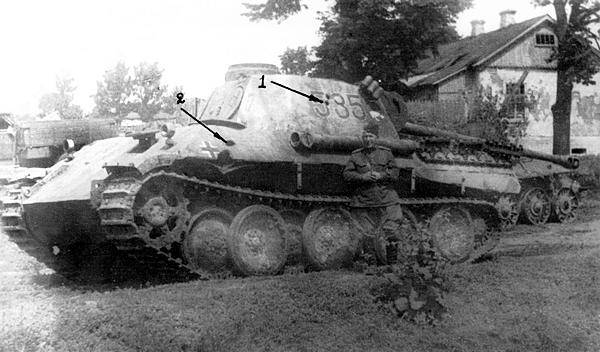
Thus, it turns out that of the total number of 41,4% fired into the German tanks fell into the Panther aircraft. And here comes the interesting question. The fact is that according to the report of the Central Research Institute No. 48, compiled in 1942, on the basis of a survey of 154 T-34 tanks with armor protection, 50,5% of the total number of shells hit these tanks.
In the comments to the articles of this cycle, it was repeatedly mentioned that this result is a consequence of the excellent training of German anti-tankists, combined with poor visibility of the 1942 T-34s and earlier years of release, as well as the weakness of the tactical training of Soviet tank crews. But now take the first-class trained German crews and Panthers, the visibility of which seems to be beyond praise. And what will we see? From the total number of hits:
1. In the frontal part of the body "Panther" had 17,2%, and for the T-34 - 22,65%. That is, German anti-tankists in the most well-protected part of the corps in 1942 were more likely to fall than their Soviet counterparts in 1943.
2. The Panther tower had almost 27,6%, and the T-34 tower had 19,4%.
3. The sides of the Panther hull had 41,4% of all hits, and the sides of the T-34 - 50,5%.
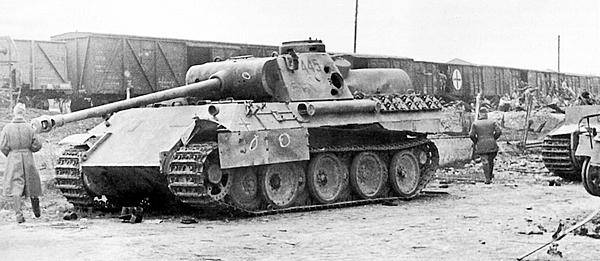
That is, in both cases, we see that one projectile falling into the frontal part of the body accounted for the 2-2,4 projectile that hit the sides of the tanks - and this value tends to 2,4 for the Panthers.
Of the total number of "Panthers" hit by artillery fire, 59% was hit in the boards. For T-34, which participated in the Stalingrad operation, this figure was 63,9%, and in the Berlin operation - 60,5%. That is, again, the numbers are close.
Of course, one cannot make far-reaching conclusions based on this statistics. Nevertheless, the panther's padded 31 was not a very representative sample, and, again, the Germans lost their tanks during an offensive operation, and part of the T-34 could have been hit during defensive operations. But in general, the similarity of the above figures indicates that the designers of the tank, intended for use in the offensive and for breaking through the enemy defenses, cannot ignore the protection of the lateral projections of their offspring. And the massive defeat of tanks in the side - this is the norm of combined arms combat, and not the consequence of the tactical illiteracy of tank crews.
About sufficiency of onboard protection
So, it turns out that the Soviet “circular” booking approach in the “all on 45” style was more correct? Of course not: primarily because, in fact, even Soviet tanks had a frontal projection defended better by the sides — the difference between their defenses was less pronounced than that of German armored vehicles.
So, for example, if we look at the T-34 reservation scheme arr. 1940 g
Then we will see that the body in the frontal projection has 45 mm, but they are located at an angle 60 deg. for the top part and 53 degrees for the bottom, but the sides have either 40 mm at an angle of 40 degrees, or 45 mm, which are strictly vertical, that is, at an angle of 0 degrees. And the subsequent thickening of the sides to 45 mm, although it strengthened their protection, but still not to the level of the frontal projection. The same thing was characteristic of the KV-1 - both the forehead and sides were protected by 75 mm armor, but the frontal parts were at an angle of 25-30 hail (and even 70 hail, but there it had "only" 60 mm), but 75-mm armor plates were mounted vertically.
Thus, no doubt, the frontal projection of any tank should be better protected than the side, but where to find the right balance of protection? If you take as a model heavy tanks, then you should pay attention to the German "Tiger" and the domestic EC-2. Their sides were protected by 80-90 mm armor (for the EC-2, it reached 120 mm), placed under a small slope or even vertically. Armor of similar thickness, and even located at an angle of 0 or close to it, could not protect the tank from specialized anti-tank artillery like ZIS-2 or Pak 40, but perfectly defended field artillery against armor-piercing shells. And this, perhaps, is the reasonable maximum that can be demanded from the side armor of a heavy tank of the Second World War era. As for the average, its sides should protect against high-explosive fragmentation shells of field artillery and armor-piercing shells of small-caliber anti-tank guns.
Of course, all of the above does not mean that medium tanks cannot be used to break through enemy defenses, but it should be understood that their comparatively weak defense will lead to significantly greater losses than if heavy tanks had done the same. But, on the other hand, the average tank should be much cheaper and more technological than heavy, and produced in much larger batches, so that in relation to their total number the losses will not be so high. But the “Panther” “managed” to combine the mass of a heavy tank with the protection of an average, so that when the enemy defenses were broken through, the Panthers were doomed to suffer significantly higher losses than classic heavy tanks like the EC-2 or Tiger. Moreover, these losses could not be compensated by large volumes of output.
About Soviet anti-tankists
Let us now look at the material part of the Soviet VET. No, the author is not going to repeat the TTX of Soviet guns used as anti-tank weapons for the umpteenth time. For the analysis, we will use such an integral indicator as the average number of hits required to disable the tank.
So in 1942, according to the analysis of the Central Research Institute 48, our 154 padded T-34s got 534 hits, or 3,46 shells per tank. But in some operations this value could be more: so, during the Battle of Stalingrad, when the level of protection T-34 already hardly corresponded to the term “counter-shells”, 4,9 shells were required on average to remove the thirty-four. It is clear that some T-34 knocked out from the first hit, and some kept 17, but on average, it turned out approximately as indicated above.
However, in 1944-45, when the T-34 booking could no longer be counted as counter-missile, there were enough 34-1,5 shells to destroy one T-1,8 — the German anti-tank artillery was seriously intensified. At the same time, in the example considered above, for disabling the 22 "Panther" there were enough 58 shells, or an 2,63 projectile per tank. In other words, the status of the armor "Panther" obviously "stuck" somewhere in the middle between the "anti-bullet" and "anti-bullet."
But, perhaps, the fact is that the Hitlerite "menagerie" near Oboya destroyed the large calibers of the self-propelled gun "hunter"? Not at all. Of the 22 Panther, four were destroyed by hits of 85-mm shells, and the rest of 18-ti was enough for 76-mm and (attention!) 45-mm armor-piercing shells!
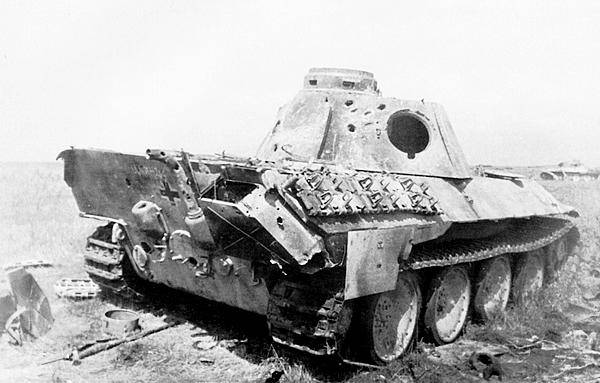
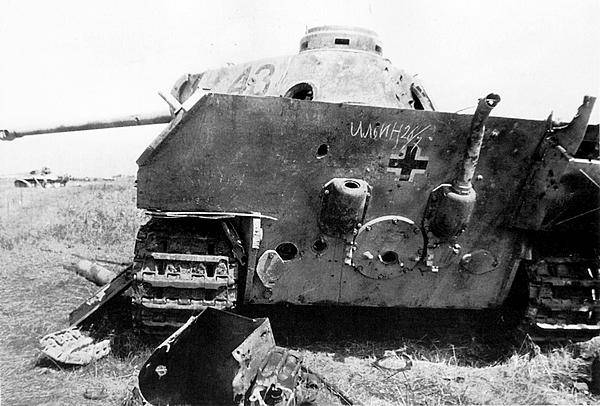
Moreover, the latter worked surprisingly well: for example, 45-mm caliber armor-piercing shells confidently penetrated the side and aft plate of the Panther tower, the mask of its gun (on the side), in one case the upper side armor was pierced. A total of 7 45-mm caliber shells hit the Panthers, armor was pierced by 6, and the seventh destroyed the barrel of a cannon. Surprisingly, but the fact is that the only snapping 45-mm projectile managed to perforate 100 mm armor of the Panther tower!
As a matter of fact, all these calculations are still nonsense. We argue a lot about the fact that the Wehrmacht received first-class anti-tank guns for armament, and the Soviet fighters had to be mostly satisfied with “forty pliers”, and the 76,2-mm universal ZIS-3, which, with all its numerous advantages, was essentially inferior to the German Pak 40, not to mention the "monsters" KwK 42 and so on. This still imposes problems with the quality of Soviet armor-piercing shells, the presence of which cannot be denied. Of course, the Panther, for all its flaws in frontal projection, radically surpassed the T-34 in defense.
But despite such an obvious advantage, the above statistics show that, on average, German tankers and anti-tankists had to hit it one or two times in order to knock out the T-34, and two or three Soviet soldiers in the Panther. There is certainly a difference, but given that the Panther could not under any circumstances be as massive a tank as the T-34 was - should it be considered so big? And will it be right to say that the domestic VET is inferior to the German one, as many are doing now?
About ergonomics
Generally speaking, the comfort of the “places of work” of the crews of German tanks is today considered to be something beyond doubt; like Caesar’s wife, she is above all suspicion. The more fun to read, for example, the following remark about the “Panther” attached to the report of G. Guderian:
Probably, in the future this problem was somehow solved, but when and how - the author, unfortunately, is unknown.
And again - about the irretrievable losses
In previous articles, the author talked about the German military paradox - with very modest irretrievable losses, the German tank units had a huge amount of military equipment in repair and scanty - in combat readiness. The situation with the "Panthers" perfectly illustrates this thesis.
Take the 39 tank regiment in which there was an 5 Panther at the start of Operation Citadel (July 200). After 5 days, i.e. July 10, irrecoverable losses accounted for the 31 machine, or just some 15,5% of the original number. It would seem that the regiment practically did not lose its combat potential ... But no: the entire 38 "Panther" is combat-ready, that is, 19% of the initial number! The rest - 131 tank - under repair.
Technical reliability
A very interesting table was drawn up by M. Kolomiyts on the state of the tank fleet of the Leibstandart Adolf Hitler division for December 1943.
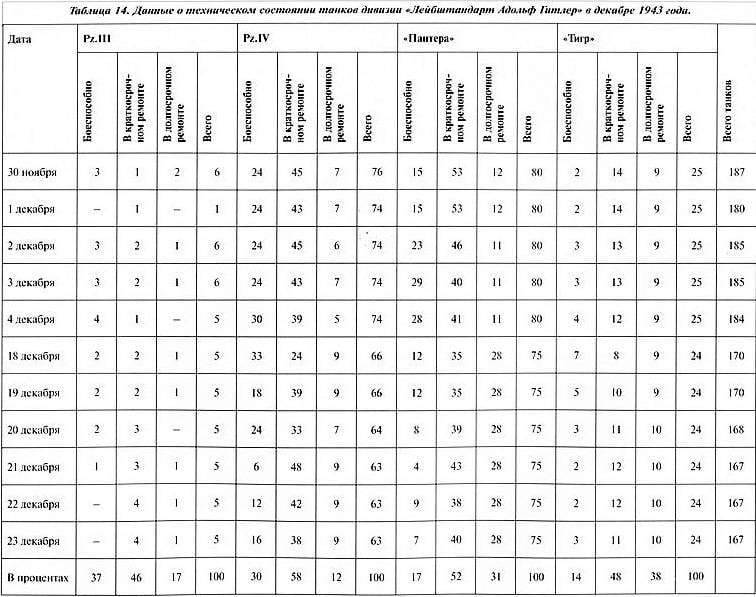
The numbers, I must say, are simply catastrophic in literally all parameters. Let's start with the fact that a division can formally be considered quite combat-ready - the list number of tanks ranges from 167 to 187 units. But the number of combat-ready tanks ranges from 13 to 66 units, that is, on average, it is even less than 24% of the total number.
From the point of view of combat losses, one would expect that the most well-protected and powerfully armed armored vehicles in battle would be better preserved - simply due to their fighting qualities, which increase its survival on the battlefield. However, with German tanks everything happened with exactly the opposite: the number of combat-ready "Tigers", the strongest and most well-armored tanks of the division, does not exceed 14% of the total number. For the next “Panther,” this indicator is only 17%, while for relatively weak “fours,” it reaches 30%.
Of course, it would be possible to try to blame everything on the crew’s unpreparedness, but this happened at the Kursk Bulge, and this means, firstly, about the end of 1943, and secondly, about a completely elite connection, which was “Leybshtandart Adolf Gitler". You can also recall the “childhood diseases” of the “Panzervaffe cats”, but even then you should not forget that the “Panthers” went into the series from February 1943, and in the yard, sorry, December, that is, almost a year has passed . About the children's diseases "Tigers", right, and already speak somehow uncomfortable.
In general, the above figures irrefutably indicate that the miraculous tank did not come out of the Panther, and that in 1943 this machine was not distinguished by any ultimatum protection or technical reliability. The Germans themselves believed that the Panther had become fully operational approximately since February 1944 - this is evidenced by a report from Guderian on March 4 from 1944 made by him on the basis of reports from combat units. Probably, the Panthers, produced in the period January-May 1944, and those were 1 468 units. were the best of all "Panther" Wehrmacht. But then Germany forcedly worsened the quality of the armor of its tanks, and the brief dawn was replaced by sunset.
In fact, even after February 1944, the crews of the Panther suffered from a number of technical flaws in this tank, but we will talk about them later when we compare the Panther with the T-34-85 ...
Продолжение следует ...
- Andrei from Chelyabinsk
- M. Kolomiets, "Heavy tank" Panther "
- Why did T-34 lose to PzKpfw III, but beat Tigers and Panthers
Why T-34 lost to PzKpfw III, but won against Tigers and Panthers. Part of 2
Why T-34 lost to PzKpfw III, but won against Tigers and Panthers. Part of 3
Why T-34 lost to PzKpfw III, but won against Tigers and Panthers. Design refinement
Pre-war structure of the armored troops of the Red Army
Why T-34 lost to PzKpfw III, but won against Tigers and Panthers. Return to brigades
Why T-34 lost to PzKpfw III, but won against Tigers and Panthers. The revival of tank corps
Soviet and German tank losses in 1942 year. Be careful with the statistics!
1942 year. German response to T-34 and KV
Top thirty-four with 76,2-mm cannon, or T-34 of model 1943 of year against T-IVH
The loss of Soviet and German armored vehicles in 1943 year. Kursk arc
About the irretrievable loss of armored vehicles of the USSR and Germany in 1943
TV "Panther": Wehrmacht "thirty-four"?
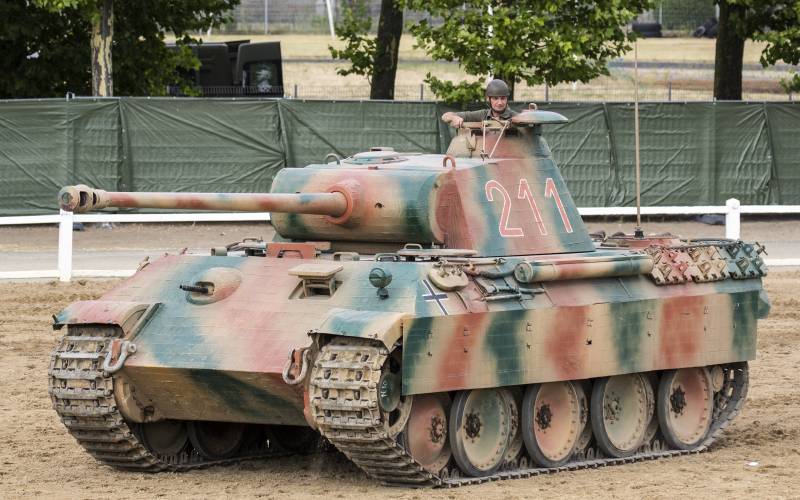

Information